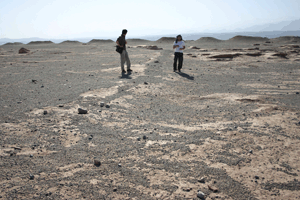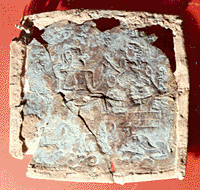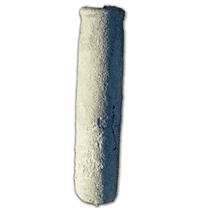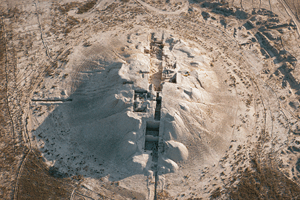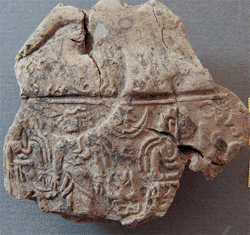The potters' marks of Tepe Yahya painstakingly compiled by DT Potts provide possible links to the evolution of 'signs' of Indus Script seen on thousands of seals and tablets from many sites of Sarasvati Civilization and of Persian or Arabian Gulf sites (so-called Dilmun seals). From the following table of Tepe Yahya master list of potters' marks, Signs 37b, 37c, 47, 51b,54a, 60a,68, 74b have clear parallels in the 'signs' of Indus Script (e.g. Mahadevan ASI Sign list 1997). These ASI Sign list entries are listed below:
Tepe Yahya Potters' mark 74b is comparable to the Pictorial Motif of a kid 'young goat' of Dholavira seals
 b
b cThese Indus Script seals from Dholavira have been deciphered as metalwork catalogues.
cThese Indus Script seals from Dholavira have been deciphered as metalwork catalogues. Dholavira seal a: meḍ 'body' rebus: meḍ 'iron'
eraka 'shoulder' rebus: eraka 'moltencast'
kolom 'three' rebus: kolimi 'smithy, forge' PLUS करडूं karaḍū 'kid' Rebus: karaḍā 'hard alloy'. Thus, hard alloy smithy, forge. Thus, the inscription signifies hard alloy smithy, forge, iron moltencastings.
Dholavira seal b: meḍ 'body' rebus: meḍ 'iron' PLUS kōḍu 'horn' rebus koḍ 'workplace' PLUS loa 'ficus glommerata' rebus: loh 'copper metal'
करडूं karaḍū 'kid' Rebus: karaḍā 'hard alloy'
kuṭhāru कुठारु [p= 289,1] m. a tree L.; a monkey Rebus: kuṭhāru कुठारु 'armourer'
Dholavira seal c: 117 antelope; sun motif. Dholavira seal impression. arka 'sun' Rebus: araka, eraka 'copper, moltencast' PLUS करडूं karaḍū 'kid' Rebus: karaḍā 'hard alloy'. Thus, together, the rebus message: hard alloy of copper.
Tepe Yahya Potters' Mark Sign 37c compares with the following Indus Script inscriptions:
m0352 cdef
Master sign list of the potters' marks from Tepe Yahya (After Fig. 5, DT Potts, 1981).
Source: The potter's marks of Tepe Yahya
Daniel Potts
Source:Paléorient,Vol. 7, No. 1 (1981), pp. 107-122
https://www.academia.edu/1905662/Potts_1981_-_The_potters_marks_of_Tepe_Yahya 















https://tinyurl.com/y96mx3u9
Lamberg-Karlovsky noted an Indus Script seal impression at Tepe Yahya.
Marhaši (Mar-ḫa-šiKI 𒈥𒄩𒅆𒆠, Marhashi, Marhasi, Parhasi, Barhasi; in earlier sources Waraḫše) was a 3rd millennium BCE polity situated east of Elam, on the Iranian plateau. It is known from Mesopotamian sources, but its precise location has not been identified, though some scholars link it with Jiroft.
https://en.wikipedia.org/wiki/Marhasi Marhasi had close contacs with Ur in 3rd millennium BCE. Water buffaloes which came from Meluhha were adored by Sargonic seal cutters. DT Potts notes an Old Babylonian copy of a royal inscription of Ibbi-Sin’s from Ur which records the dedication to Nanna of a statue of an ur gun-a Me-luh-ha ki. This statue was originally received as a gift from Marhasi. Ibbi-Sin named it ‘let him catch’ or ‘may he catch’. Steinkeller has suggested that the animal given to Ibbi-Sin was a leopard (panthera pardus).
https://www.scribd.com/document/156872759/Total-prestation-in-marhashi-ur-relations-DT-Potts-2002-Iranica-Antiqua-Vol-XXXVII
Could Marhaṣi be a metathesis of maharṣi? मह--र्षि [p= 794,2] m. a great ऋषि , any great sage or saint (accord. to Mn. i , 34 ten महर्षिs were created by मनु स्वायम्भुव , viz. मरीचि , अत्रि , अङ्गिरस्, पुलस्त्य , पुलह , क्रतु , प्रचेतस् , वसिष्ठ , भृगु , नारद , also called the 10 प्रजापतिs , q.v. ; some restrict the number to 7 , and some add दक्ष , धर्म , गौतम , कण्व , वाल्मीकि , व्यास , मनु , विभाण्डक &c )Mn. MBh. &c
( IW. 206 n. 1)(Monier-Williams)
Buffalo is an Indus Script hypertext. rango 'buffalo' rebus: rango 'pewter' (alloy of copper, zinc, tin).
Leopard (panthera pardus) is an Indus Script hypertext: खरडा kharaḍā 'A leopard' Rebus: karaḍā 'hard metal alloy'. This reading matches with the hypertext on Shahi-Tump lead weight. See:
Bronze Age Indus Script inscriptions of Mohenjo-daro on metal, are karaḍā ledger entries of metalwork wealth accounts http://tinyurl.com/yark28l7![]() Leopard weight. Shahi Tump. H.16.7cm; dia.13.5cm; base dia 6cm; handle on top.
Leopard weight. Shahi Tump. H.16.7cm; dia.13.5cm; base dia 6cm; handle on top.
Leopard weight. Shahi Tump. H.16.7cm; dia.13.5cm; base dia 6cm; handle on top.
Seashells inlays on frieze. The pair of leopard and ibex is shown twice, separated by stylized flies.
miṇḍāl 'markhor' (Tōrwālī) meḍho a ram, a sheep (Gujarati)(CDIAL 10120) Rebus: mẽṛhẽt, meḍ 'iron' (Santali.Munda.Ho.)

Ornamental ball (lead weight) discovered from Shahi Tump, Makran. It is 15 cm high and 15 kg in weight made by pure lead and wrapped in copper using cire perdue technique ca. 2500 BCE. With deciphered Indus Script hieroglyphs signifying hard alloys: karaDa 'leopard' Rebus: karaDa 'hard alloy' mlekh 'goat'' rebus: milakkhu 'copper'; mleccha 'copper'. Meluhha!!
Hieroglyph: leopard: kolha Rebus: kolhe 'smelter'. kul ‘tiger’ (Santali); kōlu id. (Te.) kōlupuli = Bengal tiger (Te.)Pk. kolhuya -- , kulha — m. ʻ jackal ʼ < *kōḍhu -- ; H.kolhā, °lā m. ʻ jackal ʼ, adj. ʻ crafty ʼ; G. kohlũ, °lũ n. ʻ jackal ʼ, M. kolhā, °lā m. krōṣṭŕ̊ ʻ crying ʼ BhP., m. ʻ jackal ʼ RV. = krṓṣṭu — m. Pāṇ. [√kruś] Pa. koṭṭhu -- , °uka — and kotthu -- , °uka — m. ʻ jackal ʼ, Pk. koṭṭhu — m.; Si. koṭa ʻ jackal ʼ, koṭiya ʻ leopard ʼ GS 42 (CDIAL 3615). कोल्हा [ kōlhā ] कोल्हें [ kōlhēṃ ] A jackal (Marathi) Rebus: kol ‘furnace, forge’ (Kuwi) kol ‘alloy of five metals, pañcaloha’ (Ta.)

 Leopards weight from Shahi-Tump (Baluchistan) made using cire perdue technique. "The artefact was discovered in a grave, in the Kech valley, in Balochistan, southern part of present Pakistan. It belongs to the Shahi Tump - Makran civilisation (end of 4th millennium -- beginning of 3rd millennium BCe). Ht. 200 mm. weight: 13.5 kg. The shell has been manufactured by lost-wax foundry of a copper alloy (12.6%b, 2.6%As), then it has been filled up through lead (99.5%) foundry. The shell is engraved with figures of leopards hunting wild goats, made of polished fragments of shellfishes. No identification of the artefact's use has been given. (Scientific team: B. Mille, D. Bourgarit, R. Besenval, Musee Guimet, Paris)."
Leopards weight from Shahi-Tump (Baluchistan) made using cire perdue technique. "The artefact was discovered in a grave, in the Kech valley, in Balochistan, southern part of present Pakistan. It belongs to the Shahi Tump - Makran civilisation (end of 4th millennium -- beginning of 3rd millennium BCe). Ht. 200 mm. weight: 13.5 kg. The shell has been manufactured by lost-wax foundry of a copper alloy (12.6%b, 2.6%As), then it has been filled up through lead (99.5%) foundry. The shell is engraved with figures of leopards hunting wild goats, made of polished fragments of shellfishes. No identification of the artefact's use has been given. (Scientific team: B. Mille, D. Bourgarit, R. Besenval, Musee Guimet, Paris)." Mille, B., R. besenval, D. Bourgarit, Early lost-wax casting in Balochistan (Pakistan): the 'Leopards Weight' from Shahi-Tump in Persiens antike Pracht, Bergau-Handwerk-Archaologie, T. Stollner, R. Slotta, A. Vatandoust, A. ed., p. 274-80. Bouchum: Deutsches Bergbau Museum, 2004.
According to archaeologist Massimo Vidale, Indus civilization weights, seals, and etched carnelian beads were found in the area, demonstrating the connections between these two cultures. (Andrew Lawler, The World in Between Volume 64 Number 6, November/December 2011 archaeology.org).
Presence of Meluhha speakers in the region of Tepe Yahya, Shahr-i-Soktha, Shahdad, Konar Sandal is attested by the following:
Section A. A seal impression with Indus Script hypertext has been found in Tepe Yahya
Section B. Indus Script hypertexts on artifacts of Marhashi Region -- Jiroft, Shahi Tump, Susa, Konar Sandal, Swat, Seistan
I suggest evolution of writing in Meluhha Indus Script attested on a potsherd of Harappa (HARP report) dated to a. 3300 BCE is the precursor to writing found in the context of Elamite tablets discussed by Michael Gross (http://www.cell.com/current-biology/fulltext/S0960-9822(12)01376-0).
Section A. Seal impression with Indus Script hypertext found in Tepe Yahya
This monograph presents evidences for the arrival of Indo-Iranian (Meluhha) speakers on the Iranian plateau in Marhashi region (including Tepe Yahya and Jiroft).
Tepe Yahya . finds with Indus Script glyphs. Seal impression. Pittman in Potts 2001: 267; Lamberg-Karlovsky & Tosi 1973: Fig. 137. Two clearly identifiable hypertexts on the seal impression which signify (copper, iron) metalwork are:
sal 'splinter'; Rebus: sal 'workshop' (Santali)
eraka 'upraised hand' Rebus: eraka '
Hieroglyph: mē̃d, mēd 'body, womb, back' Hieroglyp to signify mẽṛhẽt, meḍ ‘iron (metal)’ (Munda), med 'copper (metal)' (Slavic)
Ta. mēṉi body, shape, colour, beauty; mēl body. Ma. mēni body, shape, beauty, excellence; mēl body. Koḍ. me·lï
body. Te. mēnuid.; mēni brilliancy, lustre; belonging to the body, bodily, personal. Kol. me·n (pl. me·nḍl) body.
Nk. mēn (pl. mēnuḷ) id. Nk. (Ch.) mēn id. Pa. mēn (pl. mēnul) id. Ga. (S.) mēnu (pl. mēngil (P.) mēn id. Go. (Tr.)
mēndur (obl. mēnduḍ-), (A. Y. W. M.) mēndul, (L.)meṇḍū˘l, (SR.) meṇḍol id. (Voc. 2963). Konḍa mēndol human body. Kur. mē̃d, mēd body, womb, back. Malt. méth body. Cf. 5073 Ta.mey. (DEDR 5099) Rebus:

Section B. Indus Script hypertexts on artifacts of Marhashi region -- Jiroft, Shahi Tump, Susa, Konar Sandal, Swat, Seistan
Mcmohan cylinder seal with six signs,found in 'Swat and Seistan', unrolled photographically and the unbroken stamp-end of the seal; positive impression of the cylinder showing Harappan inscriptions (Robert Knox, 1994, A new Indus Valley Cylinder Seal, pp. 375-378 in: South Asian Archaeology 1993,Vol. I, Helsinki)
 The triangle motif is similar to the motif shown on M-443B. Possible connection with Sibri cylinder seals (which show (i) a zebu and a lion and image of a scorpion on the flat end (Shah and Parpola 1991: 413); and (ii) a zebu bull with a geometric pattern of triangles and a circle at the stamp end). "The Seistan findspot of this seal is of great interest. Evidence exists for the movement of Indus commodities, and, therefore, Indus commercial activities in the direction of western Asia and, in return, from there to the Indus world.. Evidence for the Harappan penetration of Seistan and farther to southeastern Iran is scanty but includes at least one other Indus inscription from an impression of a sherd discovered at Tepe Yahya, period IV A (c. 2200 BC) (Lamberg- Karlovsky and Tosi 1973: pl. 137)" (Knox, p. 377).
The triangle motif is similar to the motif shown on M-443B. Possible connection with Sibri cylinder seals (which show (i) a zebu and a lion and image of a scorpion on the flat end (Shah and Parpola 1991: 413); and (ii) a zebu bull with a geometric pattern of triangles and a circle at the stamp end). "The Seistan findspot of this seal is of great interest. Evidence exists for the movement of Indus commodities, and, therefore, Indus commercial activities in the direction of western Asia and, in return, from there to the Indus world.. Evidence for the Harappan penetration of Seistan and farther to southeastern Iran is scanty but includes at least one other Indus inscription from an impression of a sherd discovered at Tepe Yahya, period IV A (c. 2200 BC) (Lamberg- Karlovsky and Tosi 1973: pl. 137)" (Knox, p. 377).
फड, phaḍa 'cobra hood' फड, phaḍa 'Bhāratīya arsenal of metal weapons'
"Shahi Tump is a site in the valley of Kechi crossing the Makran in southern Pakistan It found, dating from the fourth millennium BC, a weight-filled copper lead, weighing 13.5 kg, ovoid, with a hanging loop at the top It is decorated with mosaics of shells 2 representing a leopard pursuing a gazelle This proves the mastery of copper technology in lost wax casting and that of lead, in addition to the artistic skill of the mosaic The excavations also be said that the locals were engaged at the fourth millennium, a sophisticated and developed agriculture and livestock Found there remains of wheat and barley 6-row."

फड, phaḍa 'cobra hood' फड, phaḍa 'Bhāratīya arsenal of metal weapons'
"Tepe Yahya
Tepe Yahya is located in the valley of the river Kish-e Shur, near Jiroft in Kerman province, Iran It has been occupied since the 6th millennium BC In large workshops searched, they found many ceramics and metals, especially copper and bronze But chlorite vases and cylinder seals of steatite There were also tablets, written in cuneiform The site is abandoned, then reoccupied and was finally abandoned sometime in the second half of the third millennium BCE..."

"Konar Sandal
Konar Sandal in the valley of the Halil Rud, in Kerman, is located near the town of Jiroft This site is divided into two tells part of the same city, split by a river The tell B is a high terrace In the workshops unearthed were found numerous tablets in an unknown This is the wedge that resembles the linear Elamite or Proto-Elamite In the graves were found many vases chlorite Konar Sandal should be the main center of production of these vases found throughout the Iranian plateau to Mesopotamia, the Indus Valley and around the Persian Gulf."

arye 'lion' (Akkadian) Rebus: arā 'brass' पोळा [ pōḷā ] rebus: पोळा [ pōḷā ] '
pajhar 'eagle' (rebus: pasra 'smithy')
 eruvai 'eagle' rebus: eruvai 'copper'
eruvai 'eagle' rebus: eruvai 'copper'Leopard, scorpion & zebu Indus Script hypertexts signify wealth-producing metalwork, are attested in Tepe Yahya, Jiroft & other sites of Marhashi region bordering Meluhha

Master of animals in chlorite, Jiroft, Kerman ca. 2500 BC, Bronze Age I, National Museum of Iran
Jiroft. After Figure 11: http://www.iranicaonline.org/articles/jiroft-iv-iconography-of-chlorite-artifacts.
Daniel T. Potts, Piotr Steinkeller have connected Konar-Sandal site with Marhashi (situated east of Elam, between Anshan and Meluhha).
Indus Script hypertexts on the following artifacts:
ayo 'fish' rebus: aya 'iron' ayas 'alloy metal'
kolmo 'rice plant' Rebus: kolimi 'smithy, forge'
eruvai 'eagle' rebus: eruvai 'copper'
फड, phaḍa 'cobra hood' फड, phaḍa 'Bhāratīya arsenal of metal weapons'
arye 'lion' (Akkadian) Rebus: arā 'brass' पोळा [ pōḷā ] rebus: पोळा [ pōḷā ] '
rango 'buffalo' rebus: rango 'pewter' (alloy of copper, zinc, tin),
miṇḍāl 'markhor' (Tōrwālī) meḍho a ram, a sheep (Gujarati)(CDIAL 10120) Rebus: mẽṛhẽt, meḍ 'iron' (Santali.Munda.Ho.)
dhanga 'mountain range' Rebus: dhangar 'blacksmith'
loa 'ficus glomerata' rebus: loh 'copper' [ lōhá ʻ red, copper -- coloured ʼ ŚrS., ʻ made of copper ʼ ŚBr., m.n. ʻ copper ʼ VS., ʻ iron ʼ MBh. [*rudh -- ] Pa. lōha -- m. ʻ metal, esp. copper or bronze ʼ; Pk. lōha -- m. ʻ iron ʼ, Gy. pal. li°, lihi, obl. elhás, as. loa JGLS new ser. ii 258; Wg. (Lumsden) "loa"ʻ steel ʼ; Kho. loh ʻ copper ʼ; S. lohu m. ʻ iron ʼ, L. lohā m., awāṇ. lōˋā, P. lohā m. (→ K.rām. ḍoḍ. lohā), WPah.bhad. lɔ̃u n., bhal. lòtilde; n., pāḍ. jaun. lōh, paṅ. luhā, cur. cam. lohā, Ku. luwā, N. lohu, °hā, A. lo, B. lo, no, Or. lohā, luhā, Mth. loh, Bhoj. lohā, Aw.lakh. lōh, H. loh, lohā m., G. M. loh n.; Si. loho, lō ʻ metal, ore, iron ʼ; Md. ratu -- lō ʻ copper .
*Hypertext: पोळा [ pōḷā ] zebu, bos indicus rebus: पोळा [ pōḷā ] '
Hypertext: bicha 'scorpion' rebus: bica 'stone iron ore, haematite'
Hypertext: meḍ 'dance-step' rebus: meḍ 'iron' (Mu.Ho.)
Hieroglyph: miṇḍāl 'markhor' (Tōrwālī) meḍho a ram, a sheep (Gujarati)(CDIAL 10120) Rebus: mẽṛhẽt, meḍ 'iron' (Santali.Munda.Ho.)
Meluhha Hieroglyphs from Elamite Cylinder seal Corpus of KJ Roach (2008)
Fig. 7. Catalogue, p. 126.
Source: http://www.bulletinasiainstitute.org/Muscarella_BAI15.pdf Oscar White Muscarella, Jiroft and ‘Jiroft-Aratta’ -- a review article of Yousefl Madjidzadeh, Jiroft The earliest oriental civilization, Bulletin of the Asian Institute, 15 (2005) 173-198


Map of major routes and sites of Meluhha (mleccha) interaction areas, location of Tell Abraq (adapted from Potts DT. 1994 fig.5 http://tinyurl.com/yljaqdu)
"In Mesopotamia (which in Greek means “between the rivers”), the settled agricultural people of the Tigris and Euphraties valleys evolved a form of writing. Among the earliest Mesopotamian writings are a set of clay tablets found at
The Elamite trade supplied the Sumarian civilization of Mesopotamia with silver, copper, tin, lead, precious gems, horses, timber, obsidian, alabaster and soapstone. The practical Sumerians and Elamites probably invented writing as a means of keeping accounts. The tablets found at Tepe Yahya are inscribed in proto-Elamite, and radio-carbon dating of organic remains associated with the tablets shows them to be from about
In about 3,100 B.C. the cuneiform script was developed, and later Mesopotamian tablets are written in cuneiform, which is a phonetic script where the symbols stand for syllables.
In about 3,100 B.C. the cuneiform script was developed, and later Mesopotamian tablets are written in cuneiform, which is a phonetic script where the symbols stand for syllables.
I found something interesting here:

Four examples of medieval styluses for writing on wax tablets. Two are made of iron, one brass and one bone stylus.
Posted: 01 Oct 2017 02:15 PM PDT
[First posted in AWOL 4 March 2012, updated 1 October 2017]
Excavations at Tepe Yahya, Iran in AMAR
One of a series of AWOL pages seeking to pull together publication series digitized and served through AMAR: Archive of Mesopotamian Archaeological Site Reports
http://digital.library.stonybrook.edu/cdm/compoundobject/collection/amar/id/126889/rec/4
Excavations at Tepe Yahya, Iran in AMAR
One of a series of AWOL pages seeking to pull together publication series digitized and served through AMAR: Archive of Mesopotamian Archaeological Site Reports
| Title | The proto-elamite texts from Tepe Yahya |
| Series | Bulletin (American School of Prehistoric Research) ; no. 39. |
| Author | Damerow, Peter |
| Contributor | Englund, Robert K. |
| Contributor. | Peabody Museum of Archaeology and Ethnology |
| Publisher | Cambridge, Mass. : Peabody Museum of Archaeology and Ethnology, Harvard University : Distributed by Harvard University Press, |
| Date of Publication | 1989 |
| Date of Digitization | 2010 |
| Site Name1 | Yahya, Tepe |
| Subject | Elamite language -- Writing |
| Subject. | Elamite language -- Texts |
| Language | eng |
| Description-Original | xiv, 79 p., [12] p. of plates : ill. ; 27 cm. |
| Format-Digital | PDF 184 MB (193,230,652 bytes) |
| Rights-Access Restrictions | May not be reused for commercial purposes. |
...
http://digital.library.stonybrook.edu/cdm/compoundobject/collection/amar/id/126889/rec/4
"Finally, clay tablets bearing the impressions of tokens, and then, similar shapes produced with a stylus became the record keeping, making the tokens redundant. The stylus was usually made of reed, but perhaps also of hard wood or metal: in fact one metal tool that may have been used as a stylus was found at Tepe Yahya close to some proto-Elamite tablets." -- Michael Gross
The evolution of writing
 CC Lamberg-Karlovsky and DT Potts , 2001, Excavations at Tepe Yahya, Iran, 1967-1975: the third millennium, CC Lamberg-Karlovsky, DT Potts with contributions by Holly Pittman and Philip L.Kohl, Cambridge, Massachusetts, Peabody Museum of Archaeology and Ethnology, Harvard University
CC Lamberg-Karlovsky and DT Potts , 2001, Excavations at Tepe Yahya, Iran, 1967-1975: the third millennium, CC Lamberg-Karlovsky, DT Potts with contributions by Holly Pittman and Philip L.Kohl, Cambridge, Massachusetts, Peabody Museum of Archaeology and Ethnology, Harvard University Excavations at Tepe Yahya,... by on Scribd
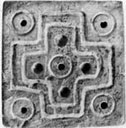










 Article Info
Article Info








